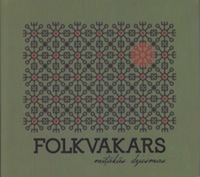Though active for many years now, the group Folkvakars (roughly translated as ‘Folk Evening’), released their first CD of their favourite Latvian folk songs in 2014, appropriately titled Mīļākās dziesmas. The group is made up of some of the best known Latvian folk musicians, and their performance at the Canadian Latvian Song Festival in 2014 in Hamilton was one of the many highlights of the festival.
The group consists of Kristīne Kārkle Puriņa on violin and vocals, Edgars Kārklis on accordion, bagpipes, stabule and vocals, Edgars Saksons on drums, Krišjānis Putniņš on guitar and Gatis Valters on bass. The extensive experience of all the members in performing Latvian folk music makes Mīļākās dziesmas one of the most refreshing and fun Latvian folk albums in recent memory.
As their name would indicate, the goal of the group is to provide for an active and lively evening of Latvian folk music, so it would be no surprise that the group’s songs tend towards to the up-tempo and active songs, rather than the slower tunes. The energetic and dynamic performances make for a memorable evening of singing and dancing. Also, as these are the group’s (and many listeners’) favorite songs, many of the songs will be familiar to Latvian folk song fans.
Not all of the songs on the CD are Latvian folk. In fact, the opening track of the album is ‘Trakais īrs’ (Crazy Irishman), a Celtic inspired instrumental that makes clear a sonic link between Irish and Latvian folk. The song also is a prelude to the occasionally rowdy music that will follow.
No folk song record would be complete without a song from the region of Latgale, and Mīļākās dziesmas provides a version of one of the most popular songs of the area – ‘Auga, auga ružeņa’ , Kārkle-Puriņa, one of the best known and distinctive voices in Latvian folk music (having performed with Valts Pūce, Trio Šmite Kārkle Cinkuss, among many others), brings the necessary fire and defiance to this song about a girl who refuses to marry the older man her parents want her to marry.
Another example of where Folkvakars deftly and ably meld multiple folk styles is in the song ‘Ē Ō’ (originally released as ‘Skaista mana tēva sēta’ on the Sviests 4 collection), where the guitars and trumpets remind the listener of Latin folk music, perhaps even elements of Mexican Mariachi music, particularly in the sound of the trumpets, giving a fresh perspective on this popular Latvian melody.
Though the song does contain a few slightly slower numbers, such as the instrumental ‘Uz kalna’, it is songs like the frenetic ‘Kas kaitēja nedzīvot’ where the vitality of the music is at its highest, and the infectious energy of the group will grab hold of the listener.
From the opening bars, Mīļākās dziesmas starts at a breakneck pace and rarely slows down, making for a rousing tour of Latvian folk songs. Dispelling the myth that Latvian songs are slow and somber, the album (and the band’s performance) reveals a vigor in these songs that cannot always be found in other folk song interpretations. As the (unfortunately all too brief) liner notes indicate, the group is made up of friends and similarly minded musicians, all of whom clearly enjoy making music and playing Latvian songs, which is one of the many reasons Mīļākās dziesmas is such an exceptional record, and unquestionably will provide for an enjoyable evening of active Latvian folk music.
For further information, please visit the group’s Facebook page.
Details
Mīļākās dziesmas
Folkvakars
2014
Track listing
- Trakais īrs
- Sprāgtin sprāga
- Kā labad(i) galdiņam
- Sasala jūriņa
- Auga, auga rūžeņa
- Jautrais stūris
- Ē Ō
- Uz kalna
- Kas kaitēja nedzīvot
- Uz Daugavas es dzīvoju
- Noriet Saule vakarā
© 1995-2024 Latvians Online
Please contact us for editorial queries, or for permission to republish material. Disclaimer: The content of Web sites to which Latvians Online provides links does not necessarily reflect the opinion of Latvians Online, its staff or its sponsors.





